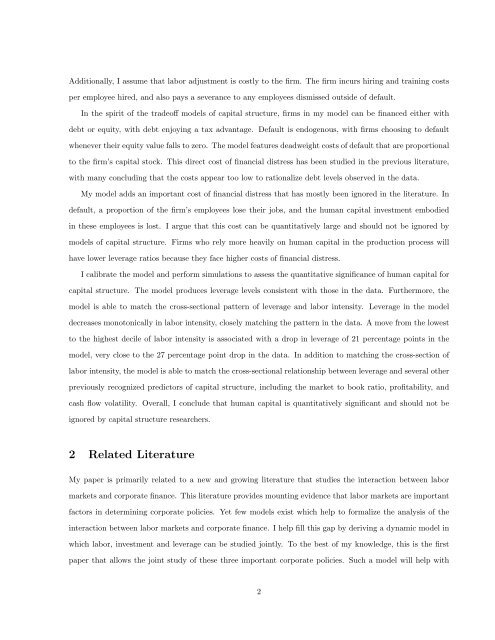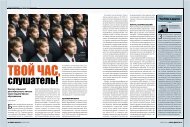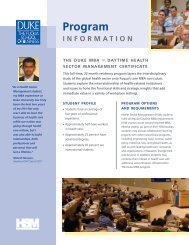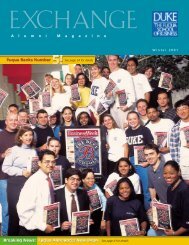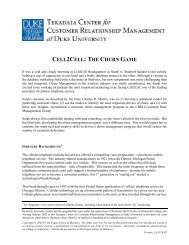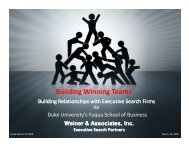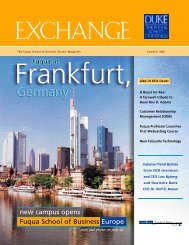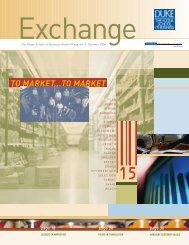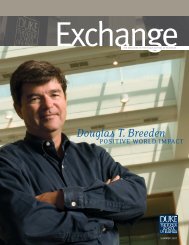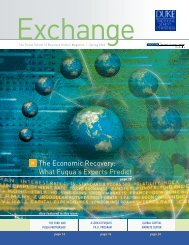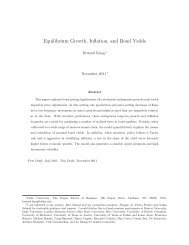A Structural Model of Human Capital and Leverage - Duke ...
A Structural Model of Human Capital and Leverage - Duke ...
A Structural Model of Human Capital and Leverage - Duke ...
You also want an ePaper? Increase the reach of your titles
YUMPU automatically turns print PDFs into web optimized ePapers that Google loves.
Additionally, I assume that labor adjustment is costly to the firm. The firm incurs hiring <strong>and</strong> training costs<br />
per employee hired, <strong>and</strong> also pays a severance to any employees dismissed outside <strong>of</strong> default.<br />
In the spirit <strong>of</strong> the trade<strong>of</strong>f models <strong>of</strong> capital structure, firms in my model can be financed either with<br />
debt or equity, with debt enjoying a tax advantage. Default is endogenous, with firms choosing to default<br />
whenever their equity value falls to zero. The model features deadweight costs <strong>of</strong> default that are proportional<br />
to the firm’s capital stock. This direct cost <strong>of</strong> financial distress has been studied in the previous literature,<br />
with many concluding that the costs appear too low to rationalize debt levels observed in the data.<br />
My model adds an important cost <strong>of</strong> financial distress that has mostly been ignored in the literature. In<br />
default, a proportion <strong>of</strong> the firm’s employees lose their jobs, <strong>and</strong> the human capital investment embodied<br />
in these employees is lost. I argue that this cost can be quantitatively large <strong>and</strong> should not be ignored by<br />
models <strong>of</strong> capital structure. Firms who rely more heavily on human capital in the production process will<br />
have lower leverage ratios because they face higher costs <strong>of</strong> financial distress.<br />
I calibrate the model <strong>and</strong> perform simulations to assess the quantitative significance <strong>of</strong> human capital for<br />
capital structure. The model produces leverage levels consistent with those in the data. Furthermore, the<br />
model is able to match the cross-sectional pattern <strong>of</strong> leverage <strong>and</strong> labor intensity. <strong>Leverage</strong> in the model<br />
decreases monotonically in labor intensity, closely matching the pattern in the data. A move from the lowest<br />
to the highest decile <strong>of</strong> labor intensity is associated with a drop in leverage <strong>of</strong> 21 percentage points in the<br />
model, very close to the 27 percentage point drop in the data. In addition to matching the cross-section <strong>of</strong><br />
labor intensity, the model is able to match the cross-sectional relationship between leverage <strong>and</strong> several other<br />
previously recognized predictors <strong>of</strong> capital structure, including the market to book ratio, pr<strong>of</strong>itability, <strong>and</strong><br />
cash flow volatility. Overall, I conclude that human capital is quantitatively significant <strong>and</strong> should not be<br />
ignored by capital structure researchers.<br />
2 Related Literature<br />
My paper is primarily related to a new <strong>and</strong> growing literature that studies the interaction between labor<br />
markets <strong>and</strong> corporate finance. This literature provides mounting evidence that labor markets are important<br />
factors in determining corporate policies. Yet few models exist which help to formalize the analysis <strong>of</strong> the<br />
interaction between labor markets <strong>and</strong> corporate finance. I help fill this gap by deriving a dynamic model in<br />
which labor, investment <strong>and</strong> leverage can be studied jointly. To the best <strong>of</strong> my knowledge, this is the first<br />
paper that allows the joint study <strong>of</strong> these three important corporate policies. Such a model will help with<br />
2


